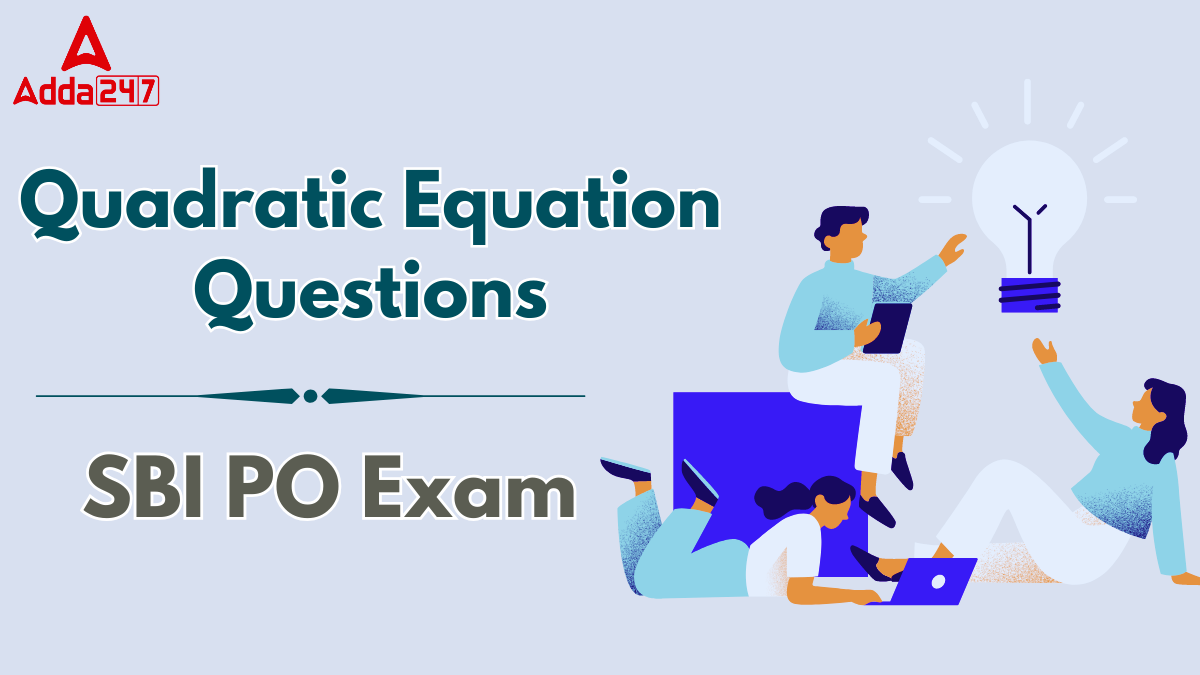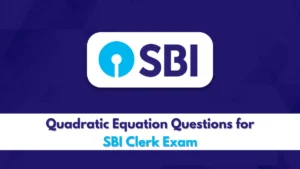The official SBI PO Exam 2025 is scheduled for 2, 4, and 5 August 2025. As you prepare for the exam, it’s important to focus on key topics. One such topic is Quadratic Equations, which is asked every year. To help you with your preparation, we have put together a set of Quadratic Equation questions specially for the SBI PO exam. Each question comes with a detailed solution to help you understand the concept better and boost your confidence.
Quadratic Equation Questions for SBI PO Exam
The Quantitative Aptitude section of the SBI PO 2025 exam includes a total of 35 questions, covering important topics like Arithmetic, Number Series, Approximation, Data Interpretation (DI), and especially Quadratic Equations. Among these, Quadratic Equations stand out as a high-scoring topic, and mostly asked every year.
Quadratic Equation Questions Asked in the Last 3 Years
In the SBI PO exam, quadratic equation questions often focus on topics like factorization, using the quadratic formula, and comparing the roots. Over the past three years, the questions have included solving for unknown values, finding the relationship between variables, and identifying maximum or minimum values. Practicing these regularly can help you improve both speed and accuracy in the exam.
Direction (1–5): In each of the following questions, two equations are given. Solve these equations and give an answer:
(a) if 𝑥 ≥ 𝑦, i.e., 𝑥 is greater than or equal to 𝑦
(b) if 𝑥 > 𝑦, i.e., 𝑥 is greater than 𝑦
(c) if 𝑥 ≤ 𝑦, i.e., 𝑥 is less than or equal to 𝑦
(d) if 𝑥 < 𝑦, i.e., 𝑥 is less than 𝑦
(e) 𝑥 = 𝑦 or no relation can be established between 𝑥 and 𝑦
Q1. I. 𝑥2 − 6𝑥 + 8 = 0
II. 𝑦2 + 8𝑦 + 15 = 0
Q2. I. 𝑥² – 12𝑥 + 32 = 0
II. 𝑦² − 17𝑦 + 72 = 0
Q3. I. 𝑥² − 12𝑥 + 35 = 0
II. 𝑦² − 11𝑦 + 24 = 0
Q4. I. 8𝑥² + 10𝑥 − 7 = 0
II. 𝑦² − 6𝑦 + 8 = 0
Q5. I. 𝑥² + 7𝑥 + 12 = 0
II. 𝑦² + 15𝑦 + 44 = 0
Directions (6-10): In each question two equations numbered (I) and (II) are given. You should solve both the equations and mark appropriate answer.
(a) if x > y
(b) if x ≥ y
(c) if x < y
(d) if x ≤ y
(e) if = y or the relationship cannot be established
Q6. I. x² – 7x + 10 = 0
II. y² – 2y – 3 = 0
Q7. I. x² – 24x + 143 = 0
II. y² – 29y + 210 = 0
Q8. I. x² + 22x + 117 = 0
II. y² + 23y + 132 = 0
Q9. I. 2x² – 3x – 20 = 0
II. 2y² + 11y + 15 = 0
Q10. I. x² – 12x + 32 = 0
II. y² – 20y + 96 = 0
Directions (11-15): In each of these questions, two equations (I) and (II) are given. Solve the equations and mark the correct option.
(a) If x> y
(b) If x≥ y
(c) If x< y
(d) If x≤ y
(e) If x = y or no relation can be established between x and y
Q11. I: 2x² + 10x + 12 = 0
II: y² + 10x + 25 = 0
Q12. I. x² – 8x + 15 =0
II. 2y² – 5y – 3 = 0
Q13. I. 6x² + x- 15 =0
II. 4y² – 24y + 35 = 0
Q14. I. 5x² + 11x + 2 = 0
II. 4y² + 13y + 3 = 0
Q15. I. x2 + 21x + 108 = 0
II. y2 + 14y + 45 = 0
Why Quadratic Equations Are a Scoring Topic in SBI PO 2025
Quadratic Equations is one of the most important and scoring topics in the SBI PO 2025 Quantitative Aptitude section. Every year around 5 to 6 questions are asked from this topic, making it a must practice area for candidates. This is what makes this topic most important.
Directions (1-5): In each of these questions, two equation (I) and (II) are given. You have to solve both the equations and give
answer
(a) If x>y
(b) If x≥y
(c) If x<y
(d) If x≤y
(e) If x = y or no relation can be established between x and y
Q1. I. x2 + 13x – 114 = 0
II. y3 = 216
Q2. I. x2 − 6x + 12 = 4
II. y2 + 4y − 10 = −13
Q3. I. 12x2 − 7x + 1 = 0
II. 20y2 − 9y + 1 = 0
Q4. I. x2 + 26x + 165 = 0
II. y2 + 23y + 132 = 0
Q5. I. x2 + x − 6 = 0
II. 15y2 − 11y + 2 = 0
Direction (6 – 10): In each of the following questions two equations are given. Solve these equations and give answer:
(a) if 𝑥 ≥ 𝑦, i.e., 𝑥 is greater than or equal to 𝑦
(b) if 𝑥 > 𝑦, i.e., 𝑥 is greater than 𝑦
(c) if 𝑥 ≤ 𝑦, i.e., 𝑥 is less than or equal to 𝑦
(d) if 𝑥 < 𝑦, i.e., 𝑥 is less than 𝑦
(e) 𝑥 = 𝑦 or no relation can be established between 𝑥 and 𝑦
Q6. (i) x2 + 9 = 73
(ii) y3 = 512
Q7. (i) x2 + 11x + 18 = 0
(ii) y2 + 19y + 90 = 0
Q8. (i). 𝑥2 − 10𝑥 + 21 = 0
(ii). 𝑦² – 5𝑦 + 6 = 0
Q9. (i) 2x2 + x − 1 = 0
(ii) 2y2 + 3y + 1 =0
Q10. (i). 2x² + 13x + 21 = 0
(ii). 2y² + 11y + 14 = 0
Direction (11 – 15): In each of these questions, two equation (I) and (II) are given.
You have to solve both the equations and give answer.
(a) If x=y or no relation can be established.
(b) If x>y
(c) If x<y
(d) If x≥y
(e) If x≤y
Q11. (I) x3 – 12 – 1319 = 0
(II) y2 – 21 – 100 = 0
Q12. I. 12𝑥2 − 7𝑥 + 1 = 0
II. 𝑦2 + 23𝑦 + 132 = 0
Q13. (I) x2+ 9x – 52 = 0
(II) 12y2 + 16y + 4 = 0
Q14. (I) x2 – x – 210 = 0
(II) y2 – 31y + 240 = 0
Q15. (I) 2x2 – 8x – 24 = 0
(II) 9y2 – 12y + 4 = 0
Directions (16-20): In each question two equations (I) and (II) are given. You should solve both the equations and mark
appropriate answer.
(a) If x > y
(b) If x ≥ y
(c) If x < y
(d) If x ≤ y
(e) If = y or the relationship cannot be established.
Q16. I. 2x² – 7x + 5 = 0
II. y² – 3y + 2 = 0
Q17. I. x² – 25x + 156 = 0
II. y² – 29y + 210 = 0
Q18. I. x² + 20x + 96 = 0
II. y² + 15y + 56 = 0
Q19. I. x² – 3x – 40 = 0
II. 2y² + 11y + 15 = 0
Q20. I. x² – 16x + 64 = 0
II. y² – 14y + 48 = 0
Solution
S1. Ans.(d)
Sol. I. x² + 13x – 114 = 0
x²+ 19x – 6x – 114 =0
x (x + 19) – 6(x + 19) = 0
(x + 19) (x – 6) = 0
x = – 19, 6
II. y3 = 216
y3 = 63
y = 6
So, 𝑥 ≤ 𝑦, i.e. 𝑥 is less than or equal to 𝑦
S2. Ans.(a)
Sol. I. 𝑥
2 − 6𝑥 + 8 = 0
𝑥2 − 2𝑥 − 4𝑥 + 8 = 0
𝑥(𝑥 − 2) − 4(𝑥 − 2) = 0
(𝑥 − 2)(𝑥 − 4) = 0
𝑥 = 2, 4
II. 𝑦2 + 4𝑦 + 3 = 0
𝑦2 + 𝑦 + 3𝑦 + 3 = 0
𝑦(𝑦 + 1) + 3(𝑦 + 1) = 0
(𝑦 + 1)(𝑦 + 3) = 0
𝑦 = −1, −3
So, 𝑥 > 𝑦
S3. Ans.(b) Sol. I. 12𝑥
2 − 7𝑥 + 1 = 0
12𝑥2 − 4𝑥 − 3𝑥 + 1 = 0
4𝑥(3𝑥 − 1) − 1(3𝑥 − 1) = 0
(3𝑥 − 1) (4𝑥 − 1) = 0
𝑥 =1/3, 1/4
II. 20𝑦2 − 9𝑦 + 1 = 0
20𝑦2 − 5𝑦 − 4𝑦 + 1 = 0
5𝑦(4𝑦 − 1) − 1(4𝑦 − 1) = 0
(4𝑦 − 1) (5𝑦 − 1) = 0
𝑦 = 1/4, 1/5
So, 𝑥 ≥ 𝑦
S4. Ans.(e)
Sol. I. 𝑥2 + 26𝑥 + 165 = 0
𝑥2 + 11𝑥 + 15𝑥 + 165 = 0
𝑥(𝑥 + 11) + 15(𝑥 + 11) = 0
(𝑥 + 11)(𝑥 + 15) = 0
𝑥 = −11, −15
II. 𝑦2 + 23𝑦 + 132 = 0
𝑦2 + 11𝑦 + 12𝑦 + 132 = 0
𝑦(𝑦 + 11) + 12(𝑦 + 11) = 0
(𝑦 + 11)(𝑦 + 12) = 0
𝑦 = −11, −12
So, no relation can be stablished
S6. Ans.(c)
Sol. (i) x2 = 73−9
x = ± 8
(ii) y = + 8
So, 𝑥 ≤ 𝑦
S7. Ans.(a)
Sol. (i) x2 + 9x + 2x + 18 = 0
x(x + 9) + 2(x + 9) = 0
x = −2, −9
(ii) y2 + 10y + 9y + 90 =0
y(y + 10) + 9(y + 10) =0
y = −9, −10
So, 𝑥 ≥ 𝑦
S8. Ans.(a)
Sol. (i). 𝑥2 − 3𝑥 − 7𝑥 + 21 = 0
𝑥(𝑥 − 3) − 7(𝑥 − 3) = 0
(𝑥 − 7)(𝑥 − 3) = 0
𝑥 = 7, 3
(ii). 𝑦2– 3𝑦– 2𝑦 + 6 = 0
𝑦(𝑦 − 3) − 2(𝑦 − 3) = 0
(𝑦 − 3)(𝑦 − 2) = 0
𝑦 = 3, 2
So, 𝑥 ≥ 𝑦
S9. Ans.(e)
Sol. (i) 2x2 + x − 1 = 0
2×2 + 2x – x – 1 = 0
2x(x + 1) −1(𝑥 + 1) = 0
x =1/2, −1
(ii) 2y2 + 3y + 1 =0
2y2 + 2y + y + 1 =0
2y(y + 1)+ 1(y + 1) = 0
y = −1, −1/2
So, no relation can be established between 𝑥 and y
S10. Ans.(e)
Sol. (i). 2×2 + 7x+6x+21 = 0
x(2x+7)+3(2x+7) = 0
(2x+7)(x+3) = 0
x = -3, -3.5
(ii). 2y² + 7y+4y + 14 = 0
y(2y+7) +2(2y+7) = 0
y = -2, -3.5
So, no relation can be established between 𝑥 and 𝑦
S11. Ans.(d)
Sol. I. x= 11
II. y=±11
So, x≥y
S12. Ans.(b)
Sol. I. 12𝑥2 − 7𝑥 + 1 = 0
12𝑥2 − 4𝑥 − 3𝑥 + 1 = 0
4𝑥(3𝑥 − 1) − 1(3𝑥 − 1) = 0
(3𝑥 − 1) (4𝑥 − 1) = 0
𝑥 = 1/3, 1/4
II. 𝑦2 + 23𝑦 + 132 = 0
𝑦2 + 11𝑦 + 12𝑦 + 132 = 0
𝑦(𝑦 + 11) + 12(𝑦 + 11) = 0
(𝑦 + 11)(𝑦 + 12) = 0
𝑦 = −11, −12
So, x>y
S13. Ans.(a)
Sol. I. x2+ 9x – 52 = 0
x2+ 13x – 4x – 52 = 0
x(x+13)-4(x+13) =0
(x+13) (x – 4) =0
x= −13, 4
II. 12y2 + 16y + 4 = 0
12y2 + 12y+4y + 4 = 0
12y(y+1)+4(y+1)=0
(12y+4)(y+1)=0
Y= –1/3, – 1
So, no relation can be established.
S14. Ans.(e)
Sol. I. x2 – x – 210 = 0
x2 –15 x+14x – 210 = 0
x(x– 15)+14(x – 15)=0
(x+14) (x – 15) =0
x= –14, 15
II. y2 – 31y + 240 = 0
y2 – 16y -15y+ 240 = 0
y(y– 16) – 15(y – 16)=0
(y – 16) (y – 15) =0
y=16, 15
so, x≤y
S15. Ans.(a)
Sol. I. 2×2 – 8x – 24 = 0
𝑥2 − 4𝑥 − 12 = 0
𝑥2 − 6𝑥 + 2𝑥 − 12 = 0
𝑥 = 6, −2
II. 9y2 – 12y + 4 = 0
9y2 −6y−6y + 4 = 0
3y(3y– 2) – 2(3y– 2)=0
(3y– 2) (3y– 2) =0
y=2/3, 2/3
So, no relation can be established.
S16. Ans.(e)
Sol. I. 2x² – 7x + 5 = 0
2x² – 2x – 5x + 5 = 0
(x – 1) (2x – 5) = 0
x = 1, 2.5
II. y² – 3y + 2 = 0
y² − y – 2y + 2 = 0
(y – 1) (y – 2) = 0
y = 1, 2
∴ 𝑛𝑜 𝑟𝑒𝑙𝑎𝑡𝑖𝑜𝑛
S17. Ans.(c)
Sol. I. x² – 25x + 156 = 0
x² – 12x – 13x + 156 = 0
(x – 12) (x – 13) = 0
x = 12, 13
II. y² – 29y + 210 = 0
y² – 14y – 15y + 210 = 0
(y – 14) (y – 15) = 0
y = 14, 15
∴ 𝑦 > 𝑥
S18. Ans.(d)
Sol. I. x² + 20x + 96 = 0
x² + 8x + 12x + 96 = 0
(x + 8) (x + 12) = 0
x = –8, –12
II. y² + 15y + 56 = 0
y² + 7y + 8y + 56 = 0
(y + 7) (y + 8) = 0
y = –7, –8
∴ x ≤ y
S19. Ans.(e)
Sol. I. x² – 3x – 40 = 0
x² – 8x + 5x – 40 = 0
x (x – 8) + 5(x – 8) = 0
(x – 8) (x + 5) = 0
x = 8, –5
II. 2y² + 11y + 15 = 0
2y² + 6y + 5y + 15 = 0
2y (y + 3) + 5 (y + 3) =0
(2y + 5) (y + 3) =0
y = –5/2, –3
So, the relationship cannot be established.
| Related Posts | |
| SBI PO Cut-Off | SBI PO Notification |
| SBI PO Salary | SBI PO Preparation Strategy |
| SBI PO Exam Date | SBI PO Previous Year Question Papers |
| SBI PO Syllabus | SBI PO Exam Pattern |




 Number Series Questions for Bank Exams
Number Series Questions for Bank Exams
 Most Important Approximation Questions f...
Most Important Approximation Questions f...
 Quadratic Equation Questions for SBI Cle...
Quadratic Equation Questions for SBI Cle...








